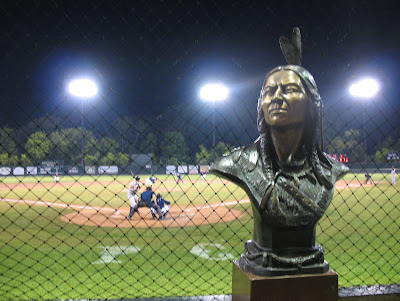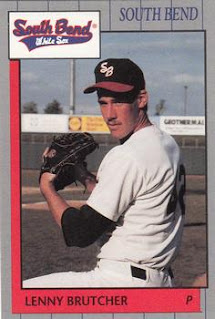Interview Part 1: Mike Malley, Ninth Inning
 |
| A Tampa Yankee comes in from the bullpen at Roger Dean Stadium in Jupiter, Fla., in 2011. Roger Dean is now home to two GCL teams. Mike Malley played in the GCL in 1988. (G21D Photo) |
Early season pitch counts limited the outings of the first two Greensboro pitchers. Mike Malley's assignment on this day in April 1989 was to pitch the ninth.
Along with preserving his team's win, that assignment included something else: Preserving a no-hitter.
"I was pretty nervous," Malley recalled to The Greatest 21 Days recently. "And you know what I did? I walked the first to players. I don't even know if I threw a strike."
The only thing he could think of, he recalled, was that his two teammates, Mo Sanford and Jerry Spradlin, had pitched their hearts out and he was going to blow it.
He didn't blow it. A double play and a pop up ended it.
"It was nice," Malley recalled. "Everybody looks at me, but I just threw the one inning. Those guys did the hard work. They got us through eight. That's the hardest part."
Malley spoke with The Greatest 21 Days recently by phone from his home in Connecticut. He capped that no-hitter in his second season as a pro. He ended up getting just two more, a shoulder injury ending his career.
 |
| A game at Trinity College in Hartford, Conn., in 2011. Mike Malley played high school ball south of Hartford and college with the University of Connecticut. (G21D Photo) |
He also talked about having to overcome a third-season shoulder injury only to come back and see the shoulder problems return.
Malley grew up playing baseball in Berlin, Ct. He played Little League and then high school ball. He recalled throwing left-handed gave him an advantage.
In high school, he had former Yankees minor leaguer Paul Baretta as a coach. Baretta played five seasons in the minors in the early 1970s, bringing some of that mentality to his job as a high school coach.
It was under Baretta that Malley recalled he started learning the intricacies of the game.
"Sometimes I didn't understand why we would do some stuff," Malley recalled. "I realized exactly what it was after I signed (as a pro) because it was the same stuff that we did in the minor leagues, the same routines, the same repetitions."
From Berlin, Malley moved on to the University of Connecticut. Baretta also moved on, to be a scout.
If he had it to do over again, Malley said maybe he would have gone south to school, where he could have practiced through the winter.
 |
| Beehive Field in New Britain, Conn., in 2008. Mike Malley grew up near New Britain, in Berlin. (G21D Photo) |
He suffered an arm injury his sophomore year. He came back for his junior year, though, serving as both starter and reliever. He recalled having some wildness, but he pitched well.
Then came his senior year. Though he was healthy, and everything else was, Malley recalled inexplicably not being pitched. He pitched just a single inning.
He recalled hearing that scouts were coming to see him pitch, but they couldn't. They also left wondering if he was hurt, or if something else was going on.
"That was a true test of how much I really wanted to finish the season out," Malley said.
But Malley had scouts watching him. After his sophomore year, his old high school coach-turned scout had Malley pitch on the side at a camp for some fellow scouts. A couple of them were interested enough to keep tabs on him.
After his lost senior season, one of those scouts, the Reds' Mickey White, invited Malley to a tryout at Quinnipiac College.
Malley's first catcher had trouble stopping Malley's pitches, the movement was too difficult for him. One of the scouts then put on the gear. Then Malley showed what he could do, hitting his spots.
 |
| A Palm Beach Cardinal delivers to the plate in 2011 at Roger Dean Stadium in Jupiter, Fla. Roger Dean is now home to two GCL teams. Mike Malley played in the GCL in 1988. (G21D Photo) |
"He said, 'well, you know what?' you'll get a chance to play pro ball,'" Malley recalled.
When draft day came, Malley wasn't sure if he'd be taken, or if he'd sign as a free agent. It took a while, but he heard the answer: He was drafted, in the 36th round.
"It was like one of the best days of my life," Malley said.
Malley found himself assigned to the rookie Gulf Coast League in Florida. It was a big change from Connecticut: 95 and humid every day, he recalled.
"The first thing I realized was the skill level," Malley said. "All the kids ran well. All the pitchers threw hard."
But Malley was able to fit in.
All along Malley had played with or against future major leaguers. In high school, he played with Mauro Gozzo. In college, he pitched along side Charles Nagy. In the Gulf Coast League, the first pitcher he faced was Darryl Kile and played with Mo Sanford.
"I kind of knew I had the ability," Malley said. "I just was fortunate that I was given the opportunity."
He ended up going 3-2 over 11 outings, two starts for the GCL Reds, ending with an ERA of 3.22. For 1989, he moved on to Greensboro, lending a hand to that combined no-hitter.
Go to Part 2: Mike Malley, Good Game
Part 1: Ninth Inning | Part 2: Good Game







